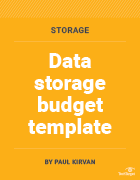How to prepare a data storage budget, with free template
Budgeting for data storage can be part of an organization's larger budget -- but make sure every line item is included. The downloadable template here can help.
Data management is a key element in IT operations, which makes a data storage budget critical for managing those resources.
A data storage budget can be part of IT's data management budget, or it could stand on its own. Many budget elements listed here include not only IT-related pieces, such as hardware and software, but also people-focused components, such as staff, office space and training. Follow best practices for optimal budget efficiency.
Data storage budget elements
The line items that follow are likely to be part of a data storage budget. They might be presented as percentage allocations or estimates from the primary IT budget.
Staffing, salaries and benefits. These elements can be listed separately or they could be part of the overall IT department budget. The organization might include a percentage allocation or estimate from the main IT staff budget.
Real estate. Infrastructure designated for data storage includes physical floor space, racks for storage devices and power supplies, raised flooring, HVAC, water detection and cable routing. Depending on how the IT budget is organized, a portion of the overall budget will be designated for real estate, with a percentage allocated to data storage. The organization might designate an estimate instead of a hard number.
Office space, conference rooms and furniture. These elements might be presented as an actual number or a percentage allocation of the overall IT budget.
Utilities. Utilities are typically shared by all parts of an IT department, although a percentage allocation might be included in a separate data storage budget.
Hardware and software purchases and maintenance. As there will be unique hardware and software associated with data storage, organizations can specifically budget for them.
Networking. Distinct network resources, such as SANs and internal LANs, designated for storage traffic might have line items. Shared network resources, such as internet access, local telecom access, and wireless and WAN services, likely will have percentages or estimates listed.
External storage. While the organization might deploy a portion of data storage locally, it might also deploy some externally using cloud storage vendors, MSPs, private clouds, hybrid cloud arrangements and third-party storage. These elements are likely to be specific line items.
Physical security. This element is likely to be a shared resource, with a percentage allocation or estimate designated for the data storage budget.
Cybersecurity management. A separate line item could address data access management and protection. A shared line item with the overall cybersecurity budget could list percentage allocations or estimates.
Disaster recovery. As this activity often closely aligns with data storage and backup, it can have its own budget line item or be a percentage allocation from an overall IT disaster recovery budget.
Administration and operations. This element might be a shared expense as part of overall IT administration and operations, with unique activities -- such as policy development -- included as line items.
Research and development. This piece can be a separate line item or a percentage allocation of the overall research and development budget.
Policy and procedure management. This element can be a separate line item or a percentage allocation of the overall IT administration and operations budget.
Risk management. This piece can be a separate line item or a percentage allocation of the overall IT or corporate risk management budget.
Training. This element can be a separate line item or a percentage allocation of the overall IT or corporate training budget.
Testing. Storage testing should be a separate line item, owing to its importance to the overall data management charter.
Audit support. Storage auditing can be a separate line item or a percentage allocation of the overall IT audit budget.
Compliance. Given the increased importance of storage compliance, it could be a separate budget item or part of the IT or corporate compliance program budget.
Environmental support. Similarly, given the importance of environmental considerations for storage, it could be a separate budget line item or part of the IT or corporate environment and sustainability program budget.
Download free data storage budget template
The free data storage budget template here helps administrators form their budgeting plans.
The template includes such budget items as salaries, data center space, hardware and software, network services, internal and external storage, cybersecurity management, disaster recovery, training and testing.
The template provides monthly columns, but admins can adjust it as needed.
Figures in each space might be a percentage allocation from a larger enterprise-level or IT corporate budget.
10 data storage budget best practices
The following are key practices to ensure that a data storage budget is prepared on time and covers the issues needed:
- Ensure senior leaders, both in IT and at the C-level, are aware of and support the preparation of a data storage budget.
- Establish a team to prepare the budget.
- Gather and review data from previous IT budgets to identify and isolate data storage budget line items.
- Compile historical data storage budget expenditures for analysis.
- Discuss budget requirements with internal data storage teams.
- Discuss data storage with internal departments to identify unique requirements.
- Prepare a draft budget for internal review, comment and approval using a spreadsheet or other internal budgeting framework.
- Ensure that internal finance management systems can use data from the budget.
- Submit the approved budget as required.
- Develop new procedures or use existing ones to monitor and review data storage expenses versus the budget.
Paul Kirvan, FBCI, CISA, is an independent consultant and technical writer with more than 35 years of experience in business continuity, disaster recovery, resilience, cybersecurity, GRC, telecom and technical writing.









